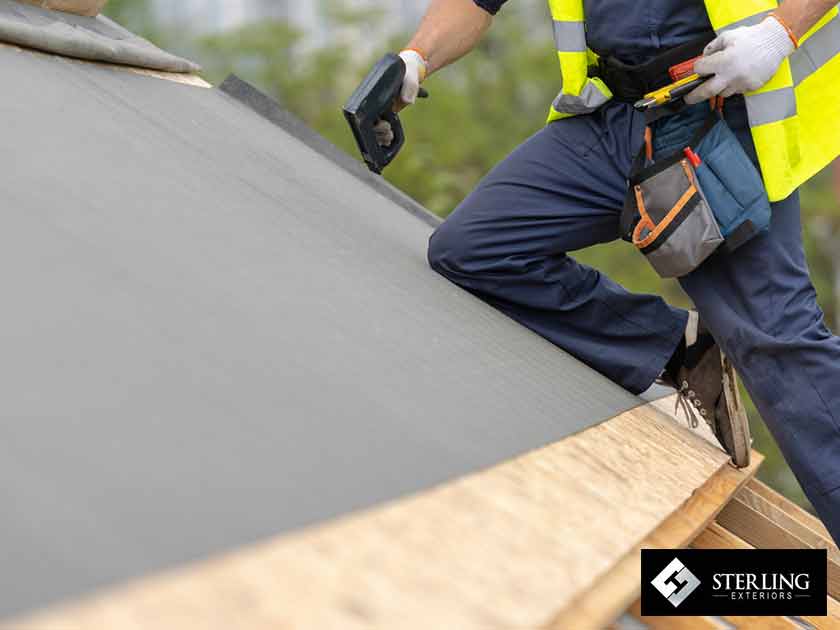Roofing systems are more intricately designed than most people realize. There’s more to the roof than the visible layer of shingles because underneath is a collection of components that work together to protect your property from weather damage — one of which is underlayment.

Some people argue that underlayment isn’t always necessary and that it should only be added to low-sloped roofs and areas where there is a high risk of moisture infiltration. However, any type of roof can benefit from the underlayment.
In this post, we share more about the significance, types and maintenance of underlayment.
Basic Facts About Underlayment
Underlayment is a thin, waterproof material between the roof decking and the asphalt shingles. While your roof system is built to resist extreme weather conditions, it is not invincible. Water and moisture can still penetrate your roof if the shingles and roof decking get damaged, making the structure prone to leaks. However, this is where underlayment comes into play. It serves as the last barrier, preventing water and moisture from reaching your attic.
The Importance of Underlayment
As a homeowner, you’ve probably experienced roof leaks so you know how inconvenient they can be. What began as a minor inconvenience could expose your property to extensive water damage. Your home needs a strong, leak-free roof, and underlayment is crucial to make that happen.
Roofing underlayment, like the gutters, protects your roofing from water infiltration. Without it, your system is more vulnerable to leaks. Aside from dramatically reducing the risk of leaks, the underlayment can also help your system last longer. This is made possible by its waterproof quality. Keeping moisture out of the system prevents mold and rot from growing on the roof structure.
Note that the trusses and decking that serve as the roof’s structural framework are often made of wood or wood composites. Rot can occur if these components are frequently exposed to moisture, weakening the roof structure. However, because underlayment allows for a stronger, longer-lasting roof structure, you may no longer have to worry about this issue. To keep it in good condition, you must schedule regular roof maintenance and inspections with a reputable local roofer.
Types of Roof Underlayment
Roof underlayment is available in different materials, each with its benefits. Because of its location between the decking and the shingles, it is not easily replaced when it becomes damaged. Typically, new underlayment is installed along with the new shingles.
Selecting the type of underlayment you’re going to use for your roof is important. Here are the choices:
- Asphalt-Saturated
Before synthetic underlayment became popular, asphalt-saturated felt was the underlayment of choice. However, asphalt-saturated remains an excellent alternative today due to its flexibility and water resistance. It also helps that it is widely available and reasonably priced. Contact a reputable roofing company like Sterling Exteriors to know if asphalt-saturated is the best option for your property.
- Non-Bitumen Synthetic
This is the most common type of roof underlayment today, so your roofer might recommend it. Non-bitumen synthetic underlayment is an immediate improvement over asphalt-saturated underlayment. It is intended for use on the entire roofing system and provides twice the strength and water resistance of asphalt-saturated underlayment.
- Rubberized Asphalt
This premium underlayment has all the advantages of the other two types of underlayment. It is completely waterproof because it has a higher percentage of asphalt and rubber polymer. The only downside is that it’s also the most expensive option.
Choosing the Right Underlayment
How should you choose a roofing underlayment? Remember that various factors can influence your decision, but one of the most crucial considerations is the kind of top layer used on your roof. Here are a few points to remember:
- Roofing felt, particularly the 15-pound roofing felt, is commonly used with asphalt shingles. It provides adequate protection while allowing air to circulate over the shingles. However, if your roof is made of metal, you should use the more heat-resistant synthetic underlayment because metal roofing retains heat more effectively than other roofing materials.
- Climate is also an important consideration. Synthetic underlayment, for example, is better suited to hotter regions or extremely damp areas. On the other hand, heavy-duty felt is more useful if you live in a windy or snowy environment.
Choosing the appropriate underlayment for your roof necessitates technical expertise. Aside from the considerations listed above, there are many more factors that you should check. It can be confusing if you are not a roofing specialist, so it’s vital to work with a reliable contractor for any roofing project. At Sterling Exteriors, we can assist you in determining which type of underlayment is most suitable for your roof.
Underlayment Maintenance
When inspecting roofing systems, pay special attention to portions of the roofline that are more exposed to the elements. The eaves and hip and ridge sections as well as any roof penetrations, such as vents and chimneys, must also be included in the inspection. These areas are prone to damage from wind-driven rain, which could result in water reaching the underlayment.
The main roof covering should also be evaluated to determine if the underlayment must be replaced too. In some cases, it’s OK to replace only the underlayment, and a lift and re-lay may be done.
As a secondary barrier, the underlayment may not require immediate replacement. This will be determined by the condition of the main water-shedding barrier, which is the roof covering. That’s why you should always consult roofing professionals.
Contact Us for All Your Roofing Needs!
Ensure your roofing underlayment is working properly! Get in touch with a professional roofer to inspect your entire roofing system. At Sterling Exteriors, we provide excellent services to all clients. With over 15 years of industry experience, our team of skilled and trained professionals is ready to help ensure quality protection for your home. You can expect professionalism and attention to detail from our crew.
To request a free, no-obligation estimate, call us at (513) 685-8055, or fill out our convenient online request form. We serve clients in Cincinnati, Newtown and Loveland, OH.






